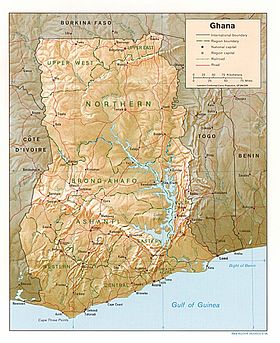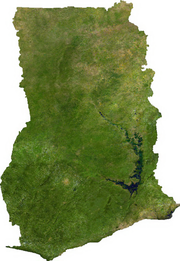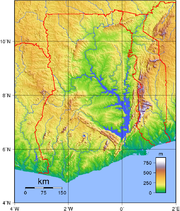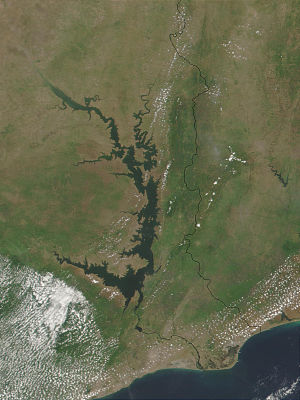
Geography of Ghana
About this schools Wikipedia selection
SOS Children offer a complete download of this selection for schools for use on schools intranets. Click here for more information on SOS Children.
 |
|
| Continent | Africa |
| Geographic coordinates | 8°00′N 2°00′W |
| Area - Total - % water |
Ranked 77th 238,540 km² 3.5% (8,520 km²) |
| Coastline | 700 km |
| Highest point | Mount Afadjato, 880 m |
| Lowest point | Atlantic Ocean, 0 m |
| Longest river | Volta River Man Made |
| Largest inland body of water | Lake Volta |
| Land Use - Arable land - Permanent crops - Permanent pastures - Forests and woodlands - Other |
12 % 7 % 22 % 35 % |
| Climate: | Tropical |
| HDI Index | ---- |
| Natural resources | gold, timber, industrial diamonds, bauxite, manganese, fish, rubber, hydropower |
| Environmental issues | drought, deforestation, overgrazing, soil erosion, poaching, habitat destruction, water pollution, drinking water |
Ghana is a country in West Africa, along the Gulf of Guinea, just a few degrees north of the equator. ![]() Wikimedia Atlas of Ghana
Wikimedia Atlas of Ghana
Location and size
Ghana, which lies in the centre of the West African coast, shares 2,093 km of land borders with the three French-speaking nations of Burkina Faso (548 km) to the north, Côte d'Ivoire (668 km) to the west, and Togo (877 km) to the east. To the south are the Gulf of Guinea and the Atlantic Ocean.
With a total area of 238,533 square kilometers, Ghana is about the size of the United Kingdom, or slightly smaller than Oregon. Its southernmost coast at Cape Three Points is 4° 30' north of the equator. From here, the country extends inland for some 670 kilometers to about 11° north. The distance across the widest part, between longitude 1° 12' east and longitude 3° 15' west, measures about 560 kilometers. The Greenwich Meridian, which passes through London, also traverses the eastern part of Ghana at Tema.
Maritime claims:
contiguous zone: 24 nmi (44.4 km; 27.6 mi)
continental shelf: 200 nmi (370.4 km; 230.2 mi)
exclusive economic zone: 200 nmi (370.4 km; 230.2 mi)
territorial sea: 12 nmi (22.2 km; 13.8 mi)
Terrain of Ghana
The terrain consists mostly low plains with the Kwahu Plateau in the south-central area. Half of the country lies less than 152 meters (499 ft) above sea level, and the highest point is 883 meters (2,897 ft). The 537 kilometers (334 mi) coastline is mostly a low, sandy shore backed by plains and scrub and intersected by several rivers and streams, most of which are navigable only by canoe. A tropical rain forest belt, broken by heavily forested hills and many streams and rivers, extends northward from the shore, near the Côte d'Ivoire frontier. This area, known as the "Ashanti," produces most of the country's cocoa, minerals, and timber. North of this belt, the country varies from 91 to 396 meters (299 to 1,299 ft) above sea level and is covered by low bush, park-like savanna, and grassy plains.
Irrigated land: 60 km² (1993 est.)
Geographical regions
Ghana is characterized in general by low physical relief. Indeed, the Precambrian rock system that underlies most of the nation has been worn down by erosion almost to a plain. The highest elevation in Ghana, Mount Afadjato in the Akwapim-Togo Ranges, rises only 880 meters above sea level.
There are, nonetheless, five distinct geographical regions. Low plains stretch across the southern part of the country. To their north lie three regions--the Ashanti Uplands, the Akwapim-Togo Ranges, and the Volta Basin. The fifth region, the high plains, occupies the northern and northwestern sector of the country (see fig. 4). Like most West African countries, Ghana has no natural harbors. Because strong surf pounds the shoreline, two artificial harbors were built at Takoradi and Tema (the latter completed in 1961) to accommodate Ghana's shipping needs.
Low Plains
The low plains comprise the four subregions of the coastal savanna, the Volta Delta, the Accra Plains, and the Akan Lowlands. A narrow strip of grassy and scrubby coast runs from a point near Takoradi in the west to the Togo border in the east. This coastal savanna, only about eight kilometers in width at its western end, stretches eastward through the Accra Plains, where it widens to more than eighty kilometers, and terminates at the southeastern corner of the country at the lower end of the Akwapim-Togo Ranges.
Almost flat and featureless, the Accra Plains descend gradually to the gulf from a height of about 150 meters. The topography east of the city of Accra is marked by a succession of ridges and spoonshaped valleys. The hills and slopes in this area are the favored lands for cultivation. Shifting cultivation is the usual agricultural practice because of the swampy nature of the very lowlying areas during the rainy seasons and the periodic blocking of the rivers at the coast by sandbars that form lagoons. A plan to irrigate the Accra Plains was announced in 1984. Should this plan come to reality, much of the area could be opened to large-scale cultivation.
To the west of Accra, the low plains contain wider valleys and rounded low hills, with occasional rocky headlands. In general, however, the land is flat and covered with grass and scrub. Dense groves of coconut palms front the coastline. Several commercial centers, including Winneba, Saltpond, and Cape Coast, are located here. Although Winneba has a small livestock industry and palm tree cultivation is expanding in the area away from the coast, the predominant occupation of the coastal inhabitants is fishing by dug-out canoe.
The Volta Delta, which forms a distinct subregion of the low plains, extends into the Gulf of Guinea in the extreme southeast. The delta's rock formation--consisting of thick layers of sandstone, some limestone, and silt deposits--is flat, featureless, and relatively young. As the delta grew outward over the centuries, sandbars developed across the mouths of the Volta and smaller rivers that empty into the gulf in the same area, forming numerous lagoons, some quite large, making road construction difficult. To avoid the lowest-lying areas, for example, the road between Accra and Keta makes an unusual detour inland just before reaching Ada and finally approaches Keta from the east along the narrow spit on which the town stands. This notwithstanding, road links with Keta continue to be a problem. By 1989 it was estimated that more than 3,000 houses in the town had been swallowed by flooding from the lagoon. In addition, about 1,500 other houses were destroyed by erosion caused by the powerful waves of the sea.
Ironically, it is this flat, silt-composed delta region with its abundance of water that supports shallot, corn, and cassava cultivation in the region. Moreover, the sandy soil of the delta gave rise to the copra industry. Salt-making, from the plentiful supply in the dried beds of the lagoons, provides additional employment. The main occupation of the delta people, however, continues to be fishing, an industry that supplies dried and salted fish to other parts of the country.
The largest part of the low plains is the Akan Lowlands. Some experts prefer to classify this region as a subdivision of the Ashanti Uplands because of the many characteristics they share. Unlike the uplands, however, the height of the Akan Lowlands is generally between sea level and 150 meters. Some ranges and hills rise to about 300 meters, but few exceed 600 meters. The lowlands that lie to the south of the Ashanti Uplands receive the many rivers that make their way to the sea.
The Akan Lowlands contain the basins of the Densu River, the Pra River, the Ankobra River, and the Tano River, all of which play important roles in the economy of Ghana. The Densu River Basin, location of the important urban centers of Koforidua and Nsawam in the eastern lowlands, has an undulating topography. Many of the hills here have craggy summits, which give a striking appearance to the landscape. The upper section of the Pra River Basin, to the west of the Densu, is relatively flat; the topography of its lower reaches, however, resembles that of the Densu Basin and is a rich cocoa and food-producing region. The valley of the Birim River, one of the main tributaries of the Pra, is the country's most important diamond-producing area.
The Ankobra River Basin and the middle and lower basins of the Tano River to the west of the lowlands form the largest subdivision of the Akan Lowlands. Here annual rainfall between 1,500 and 2,150 millimeters helps assure a dense forest cover. In addition to timber, the area is rich in minerals. The Tarkwa goldfield, the diamond operations of the Bonsa Valley, and high-grade manganese deposits are all found in this area. The middle and lower Tano basins have been intensely explored for oil and natural gas since the mid-1980s. The lower basins of the Pra, Birim, Densu, and Ankobra rivers are also sites for palm tree cultivation.
Ashanti Uplands
Comprising the Southern Ashanti Uplands and the Kwahu Plateau, the Ashanti Uplands lie just north of the Akan Lowlands and stretch from the Côte d'Ivoire border in the west to the elevated edge of the Volta Basin in the east. Stretching in a northwest-to-southeast direction, the Kwahu Plateau extends 193 kilometers between Koforidua in the east and Wenchi in the northwest. The average elevation of the plateau is about 450 meters, rising to a maximum of 762 meters. The relatively cool temperatures of the plateau were attractive to Europeans, particularly missionaries, who founded many well-known schools and colleges in this region.
The plateau forms one of the important physical divides in Ghana. From its northeastern slopes, the Afram and Pru Rivers flow into the Volta River, while from the opposite side, the Pra, Birim, Ofin, Tano, and other rivers flow south toward the sea. The plateau also marks the northernmost limit of the forest zone. Although large areas of the forest cover have been destroyed through farming, enough deciduous forest remains to shade the head waters of the rivers that flow from the plateau.
The Southern Ashanti Uplands, extending from the foot of the Kwahu Plateau in the north to the lowlands in the south, slope gently from an elevation of about 300 meters in the north to about 150 meters in the south. The region, however, contains several hills and ranges as well as several towns of historical and economic importance, including Kumasi, Ghana's second largest city and former capital of the Asante (also seen as Ashanti--see Glossary) empire (see The Precolonial Period , ch. 1). Obuasi and Konongo, two of the country's gold-mining centers, are also located here. The region is the country's chief producer of cocoa, and its tropical forests continue to be a vital source of timber for the lumber industry.
Volta Basin
Occupying the central part of Ghana, the Volta Basin covers about 45 percent of the nation's total land surface. Its northern section, which lies above the upper part of Lake Volta, rises to a height of 150 to 215 meters above sea level. Elevations of the Konkori Scarp to the west and the Gambaga Scarp to the north reach from 300 to 460 meters. To the south and the southwest, the basin is less than 300 meters. The Kwahu Plateau marks the southern end of the basin, although it forms a natural part of the Ashanti Uplands.
The basin is characterized by poor soil, generally of Voltaian sandstone. Annual rainfall averages between 1,000 and 1,140 millimeters. The most widespread vegetation type is savanna, the woodlands of which, depending on local soil and climatic conditions, may contain such trees as Red Ironwood and Shea.
The basin's population, principally farmers, is low in density, especially in the central and northwestern areas of the basin, where tsetse flies are common. Archeological finds indicate, however, that the region was once more heavily populated. Periodic burning evidently occurred over extensive areas for perhaps more than a millennium, exposing the soil to excessive drying and erosion, rendering the area less attractive to cultivators.
In contrast with the rest of the region are the Afram Plains, located in the southeastern corner of the basin. Here the terrain is low, averaging 60 to 150 meters in elevation, and annual rainfall is between 1,140 and about 1,400 millimeters. Near the Afram River, much of the surrounding countryside is flooded or swampy during the rainy seasons. With the construction of Lake Volta (85.15 km² in area) in the mid-1960s, much of the Afram Plains was submerged. Despite the construction of roads to connect communities displaced by the lake, road transportation in the region remains poor. Renewed efforts to improve communications, to enhance agricultural production, and to improve standards of living began in earnest only in the mid-1980s.
High plains
The general terrain in the northern and northwestern part of Ghana outside the Volta Basin consists of a dissected plateau, which averages between 150 and 300 meters in elevation and, in some places, is even higher. Rainfall averages between 1,000 and 1,150 millimeters annually, although in the northwest it is closer to 1,350 millimeters. Soils in the high plains are more arable than those in the Volta Basin, and the population density is considerably higher. Grain and cattle production are the major economic activities in the high plains of the northern region. Since the mid-1980s, when former United States President Jimmy Carter's Global 2000 program (see Glossary) adopted Ghana as one of a select number of African countries whose local farmers were to be educated and financially supported to improve agricultural production, there has been a dramatic increase in grain production in northern Ghana. The virtual absence of tsetse flies in the region has led, moreover, to increased livestock raising as a major occupation in the north. In fact, the region is the country's largest producer of cattle.
Rivers and lakes
Ghana is drained by a large number of streams and rivers. In addition, there are a number of coastal lagoons, the huge man-made Lake Volta, and Lake Bosumtwi, southeast of Kumasi and which has no outlet to the sea. In the wetter south and southwest areas of Ghana, the river and stream pattern is denser, but in the area north of the Kwahu Plateau, the pattern is much more open, making access to water more difficult. Several streams and rivers also dry up or experience reduced flow during the dry seasons of the year, while flooding during the rainy seasons is common.
The major drainage divide runs from the southwest part of the Akwapim-Togo Ranges northwest through the Kwahu Plateau and then irregularly westward to the Côte d'Ivoire border. Almost all the rivers and streams north of this divide form part of the Volta system. Extending about 1,600 kilometers in length and draining an area of about 388,000 square kilometers, of which about 158,000 km² lie within Ghana, the Volta and its tributaries, such as the Afram River and the Oti River, drain more than twothirds of the country. To the south of the divide are several smaller, independent rivers. The most important of these are the Pra River, the Tano River, the Ankobra River, the Birim River, and the Densu River. With the exception of smaller streams that dry up in the dry seasons or rivers that empty into inland lakes, all the major rivers in the country flow into the Gulf of Guinea directly or as tributaries to other major rivers. The Ankobra and Tano are navigable for considerable distances in their lower reaches.
Navigation on the Volta River has changed significantly since 1964. Construction of the dam at Akosombo, about eighty kilometers upstream from the coast, created vast Lake Volta and the associated 768 megawatt hydroelectric project. Arms of the lake extended into the lower-lying areas, forcing the relocation of 78,000 people to newly created townships on the lake's higher banks. The Black Volta River and the White Volta River flow separately into the lake. Before their confluence was submerged, the rivers came together in the middle of the country to form the main Volta River. The Oti River and the Daka River, the principal tributaries of the Volta in the eastern part of the country, and the Pru River, the Sene River, and the Afram River, major tributaries to the north of the Kawhu Plateau, also empty into flooded extensions of the lake in their river valleys. Lake Volta is a rich source of fish, and its potential as a source for irrigation is reflected in agricultural mechanization agreement signed in the late 1980s to irrigate the Afram Plains. The lake is navigable from Akosombo through Yeji in the middle of the country; a 24 meter pontoon was commissioned in 1989 to link the Afram Plains to the west of the lake with the lower Volta region to the east. Hydroelectricity generated from Akosombo supplies Ghana, Togo, and Benin.
On the other side of the Kwahu Plateau from Lake Volta are several river systems, including the Pra, Ankobra, Tano and Densu. The Pra is the easternmost and the largest of the three principal rivers that drain the area south of the Volta divide. Rising south of the Kwahu Plateau and flowing southward, the Pra enters the Gulf of Guinea east of Takoradi. In the early part of the twentieth century, the Pra was used extensively to float timber to the coast for export. This trade is now carried by road and rail transportation.
The Ankobra, which flows to the west of the Pra, has a relatively small drainage basin. It rises in the hilly region of Bibiani and flows in a southerly direction to enter the gulf just west of Axim. Small craft can navigate approximately eighty kilometers inland from its mouth. At one time, the Ankobra helped transport machinery to the gold-mining areas in the vicinity of Tarkwa. The Tano, which is the westernmost of the three rivers, rises near Techiman in the centre of the country. It also flows in a southerly direction, but it empties into a lagoon in the southeast corner of Côte d'Ivoire. Navigation by steam launch is possible on the southern sector of the Tano for about 70 kilometers.
A number of rivers are found to the east of the Pra. The two most important are the Densu and Ayensu, both of which rise in the Atewa Range, and which are important as sources of water for Accra and Winneba respectively. The country has one large natural lake, Lake Bosumtwi, located about 32 kilometers southeast of Kumasi. It occupies the steep-sided meteoric crater and has an area of about 47 square kilometers. A number of small streams flow into Lake Bosumtwi, but there is no drainage from it. Apart from providing an opportunity for fishing for local inhabitants, the lake serves as a tourist attraction!
Natural hazards
Dry, dusty, harmattan winds occur from January to March. The country is also prone to droughts, and was severely affected by floods in 2007 and 2009.
Environment
The recent drought in the north has had a severe effect on agriculture. Wildlife is threatened by poaching and habitat destruction threatens wildlife populations.
International agreements (ratified):
Biodiversity, Climate Change, Desertification, Endangered Species, Environmental Modification, Law of the Sea, Nuclear Test Ban, Ozone Layer Protection, Ship Pollution, Tropical Timber 83, Tropical Timber 94, Wetlands
International agreements (signed, but not ratified)
Marine Life Conservation
Other
Volta Lake, the largest artificial lake in the world, extends from the Akosombo Dam in southeastern Ghana to the town of Yapei, 520 kilometers (323 mi) to the north. The lake generates electricity, provides inland transportation, and is a potentially valuable resource for irrigation and fish farming.



